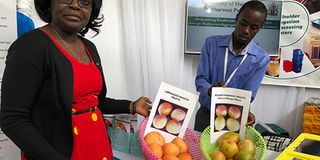Six ways to keep your fruits, tubers and vegetables fresh

Dr Jane Ambuko, a post-harvest expert displays unwaxed mangoes (left) and waxed ones (right) to show the effect of waxing technologies on the mangoes. The waxed mangoes still retain their fresh green colour several days after being harvested. PHOTO | BRIAN OKINDA | NMG
What you need to know:
- 40-50 per cent of fruits and vegetables produced in Kenya are lost or wasted along the supply chain.
- From using pots to wax, charcoal and water, there are many simple ways to make your fresh produce stay longer.
- These technologies, some which can be fabricated on the farm, can save farmers losses of up to 40 per cent of harvest.
- Better management and post-harvest technology adoption are key to the realisation of reduced losses in agriculture value chains while ensuring better returns for the farmer.
There are several simple technologies that a farmer can adapt and use on the farm to curb post-harvest losses of agricultural produce like vegetables, fruits and grains.
These technologies, some which can be fabricated on the farm, can save farmers losses of up to 40 per cent of harvest.
Dr Jane Ambuko, a post-harvest expert at the Department of Plant Science and Crop Protection, University of Nairobi, estimates that 40-50 per cent of fruits and vegetables produced in Kenya are lost or wasted along the supply chain.
“The losses are caused by lack of access to affordable and appropriate technologies for handling, storage and processing of the highly perishable commodities,” she says.
Therefore, better management and post-harvest technology adoption are key to the realisation of reduced losses in agriculture value chains while ensuring better returns for the farmer. Dr Ambuko shared with Seeds of Gold the simple technologies that can help you curb food losses.
Pot-in-pot evaporative cooler
In this technology, a small clay pot is inserted into a large one leaving space between the two. The cavity is filled with sand, which serves as a medium for holding water for the evaporative cooling.
The technology, according to her, is best suited for household use because of the small volume of produce storable.
“You can preserve any type of perishable product using this technology. It acts as a mini-fridge. You can store vegetables, milk, fruits, tomatoes and any other commodity that perishes quickly,” she says.
Fruit waxing technologies
The shelf-life of perishable fruits like mangoes can be extended by coating them with wax, says Dr Ambuko.
The wax used is a special kind of food grade wax which is safe for food preservation. It replaces the natural wax found on mature fruits and which is often washed off or removed during handling.

The Pot-in-pot evaporative cooler (left) and the Zero energy brick cooler (right) technologies which are used in produce preservation. These technologies, some which can be fabricated on the farm, can save farmers losses of up to 40 per cent of harvest. PHOTO | BRIAN OKINDA & FILE | NMG
Waxing slows down diffusion of water and gas from the fruits thereby reducing their water loss and respiration, hence prolong their shelf-life.
Respiration and transpirational water loss contribute to deterioration of fruits and vegetables after harvest. Dr Ambuko notes wax used for food preservation is not cancerous as might have been thought because it is developed/produced specifically for the purpose of food preservation.
Plastic crates
Packaging fruits and vegetables in crates instead of sacks reduces mechanical injuries during transportation.
Plastic crates are recommended for handling and storage of produce because they can be cleaned and sanitised regularly to avoid contamination of the packaged food.
Good quality plastic crates can be reused for a long time, while nestable crates are a space-saving alternative to the ordinary bread crates.
The nestable plastic crates are recommended for transporters who often have to move them empty after delivering produce to the market.
DryCard
This is an inexpensive device developed by researchers at University of California, Davis, and helps in determining if dried food is dry enough to be stored to prevent mould growth during storage.
A DryCard incorporates a cobalt chloride humidity indicator strip that changes its colour with changing relative humidity.

Isaac Nyangena, a food science masters student who works with Dr Ambuko in the Rockefeller Foundation’s YieldWise Initiative and the National Research Fund (NRF-Kenya)-sponsored postharvest programme, demonstrates how the Drycard works (left) and (right) a sample of the modified atmosphere packaging (MAP) for storage of fresh produce. PHOTO | BRIAN OKINDA | NMG
“It turns from blue to pink as it absorbs moisture from its surrounding and hence can be used to establish the dryness in grains, dried fruits and vegetables among other commodities,” says Isaac Nyangena, a food science masters student.
Zero energy brick cooler (ZEBC)
This is a simple structure made from locally available materials such as bricks, sand, water-tank and drip lines and a cover
The ZEBC can easily be fabricated on the farm, with optimal dimensions of 2 metres (width) and 3 metres (length).
The cooling capacity achievable in the structure is between 5-15 degrees centigrade. It can also attain a relative humidity of more than 50 per cent above ambient air relative humidity.
These factors help preserve quality of fruits and vegetables.
Modified atmosphere packaging (MAP)
MAP refers to elevated concentrations of carbon dioxide and reduced levels of oxygen and ethylene in the storage environments, which can be achieved by enclosing/wrapping the produce in certain polymeric films.
Benefits include reduced respiration, slowed softening and compositional changes, and reduced deterioration and decay.
These benefits contribute to extending the shelf-life of the packaged commodities.
It is, however, advisable that a suitable MAP be selected for each commodity due to their differences in nature which affects their effectiveness.





